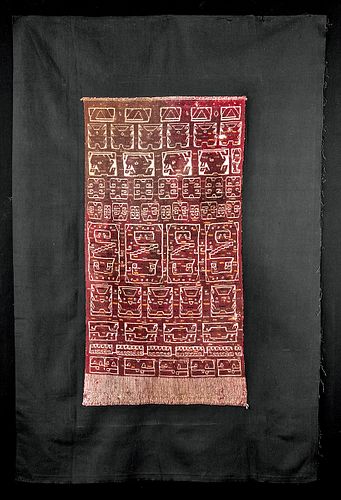Pachacamac Polychrome Textile Panel - Abstract Animals
Lot 109c
About Seller
Artemis Fine Arts
686 S Taylor Ave, Ste 106
Louisville, CO 80027
United States
Selling antiquities, ancient and ethnographic art online since 1993, Artemis Gallery specializes in Classical Antiquities (Egyptian, Greek, Roman, Near Eastern), Asian, Pre-Columbian, African / Tribal / Oceanographic art. Our extensive inventory includes pottery, stone, metal, wood, glass and textil...Read more
Estimate:
$1,800 - $2,500
Absentee vs Live bid
Two ways to bid:
- Leave a max absentee bid and the platform will bid on your behalf up to your maximum bid during the live auction.
- Bid live during the auction and your bids will be submitted real-time to the auctioneer.
Bid Increments
| Price | Bid Increment |
|---|---|
| $0 | $25 |
| $300 | $50 |
| $1,000 | $100 |
| $2,000 | $250 |
| $5,000 | $500 |
| $10,000 | $1,000 |
| $20,000 | $2,500 |
| $50,000 | $5,000 |
| $100,000 | $10,000 |
| $200,000 | $20,000 |
About Auction
By Artemis Fine Arts
Feb 13, 2020
Set Reminder
2020-02-13 10:00:00
2020-02-13 10:00:00
America/New_York
Bidsquare
Bidsquare : Exceptional Antiquities, Asian, Ethnographic
https://www.bidsquare.com/auctions/artemis-gallery/exceptional-antiquities-asian-ethnographic-4848
An important one-day auction featuring museum-worthy examples of Egyptian, Greek, Roman, Etruscan, Near Eastern, Far East / Asian, Pre-Columbian, African / Tribal, Oceanic, Native American, Spanish Colonial, Russian, Fossils, Ancient Jewelry, Fine Art, so much more! Artemis Fine Arts info@artemisfinearts.com
An important one-day auction featuring museum-worthy examples of Egyptian, Greek, Roman, Etruscan, Near Eastern, Far East / Asian, Pre-Columbian, African / Tribal, Oceanic, Native American, Spanish Colonial, Russian, Fossils, Ancient Jewelry, Fine Art, so much more! Artemis Fine Arts info@artemisfinearts.com
- Lot Description
Pre-Columbian, central/south coast Peru, Lurin Valley, Pachacamac culture, ca. 1000 to 1500 CE. An intriguing example of a densely decorated textile panel formed from tightly woven camelid (alpaca or llama wool) fibers in hues of crimson, cream, marigold, periwinkle, sage, and jet. The body of the textile features several registers of abstract zoomorphic creatures and geometric motifs that show (from top to bottom) enclosed triangles, abstract frogs, ambiguous animals, turtle shells, abstract insects, enclosed serpents, abstract octopi, bicephalic serpents, mirrored waveform motifs, and additional enclosed abstract forms. Dotting the entire textile are petite dashes of yellow, black, green, blue, or black hues, and the bottom of the body displays a vertically oriented, red-and-white panel. Mounted on a museum-quality display fabric. Size (textile): 16" W x 31" H (40.6 cm x 78.7 cm); (display fabric): 31.25" W x 47.25" H (79.4 cm x 120 cm)
Pachacamac is located on the Peruvian coast approximately 32 kilometers south of Lima. It was a sacred site, as well as an oracle, and place of burial, that pilgrims from numerous ancient Andean cultures visited, including the Incas. Active for more than 2,000 years, this site was named after the god Pacha Kamaq who was worshipped as the "Maker of the Earth" by these coastal peoples and was also associated with powerful earthquakes. According to indigenous mythology, Pachacamac had defeated Con, the rival creator god who as a form of punishment for humankind's evilness had stopped all rainfall. Pachacamac resorted to transforming humanity into animals and subsequently created an entirely new race of men and women. Some versions of the myth tell of the god sending four stars to earth. Two of the stars were male and became kings and nobility. The other two stars were female and became common folk.
Provenance: private Hawaii, USA collection; ex-private Hans Juergen Westermann collection, Germany, collected in the 1950s to 1960s
All items legal to buy/sell under U.S. Statute covering cultural patrimony Code 2600, CHAPTER 14, and are guaranteed to be as described or your money back.
A Certificate of Authenticity will accompany all winning bids.
We ship worldwide and handle all shipping in-house for your convenience.
#150882Repairs to a few small areas on body using modern thread. Minor fraying and loosening to some interior threads, with staining and fading to areas of original pigmentation, and minor creasing. Iconography and original pigments are still visible.Condition
- Shipping Info
-
All shipping is handled in-house for your convenience. Your invoice from Artemis Gallery will include shipping calculation instructions. If in doubt, please inquire BEFORE bidding for estimated shipping costs for individual items.
-
- Buyer's Premium



 EUR
EUR CAD
CAD AUD
AUD GBP
GBP MXN
MXN HKD
HKD CNY
CNY MYR
MYR SEK
SEK SGD
SGD CHF
CHF THB
THB














